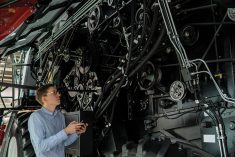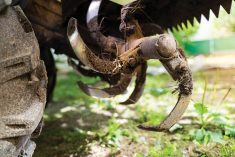As combines and augers fall silent and snow and cold settle in, and aches and pains from working from dawn to dusk start to ease up, now is the time to rethink how to approach farm work from an ergonomic standpoint.
Ergonomics is the science of analyzing the effect of work processes, job designs, and work environment on human performance and health. The main purpose of ergonomics is to reduce stressors on the human body resulting from job tasks and/or the work environment in order to prevent health problems and improve work efficiency and productivity. In a nutshell, good ergonomics is about using your brain more than your back.
Read Also

Gentle treatments for pain in the neck
Heading toward year-end, people unknowingly tense up against the cold and busyness, causing neck pain that can often be treated with appropriate support and gentle mobility, athletic therapist Kathlyn Hossack says.
There are plenty of ergonomic risks on the farm. Just think of all the tasks that require lifting, carrying, pushing, pulling, repetitive motions and awkward positions. Even tasks that involve vibration (riding in a rough tractor all day), or cold and heat and contact stress (coming into contact with an inflexible surface repetitively) can be ergonomic risks.
Thinking about and planning tasks before tackling them can save aches, pains and, potentially, your life.
Redesign the job. Think about the strenuous jobs that need to be done on the farm, the objects being handled (weight, size, shape, handles) and the workstations (dimensions, layout, adjustability). And then think about what can be changed to make the job easier.
Education is important. Understand the basics of body mechanics. Be able to recognize high-risk tasks and be able to identify the early signs and symptoms of a musculoskeletal injury.
Think of heavy work solutions such as the following:
- Provide mechanical aids such as conveyors, floor cranes, carts, balancing mechanisms, vacuum hoists, turntables, tilt tables, hooks, automatic pushers, wheels, etc.
- Minimize the total cumulative weight handled each day.
- Change from lifting to pushing or from pushing to rolling.
- Introduce team lifting.
- Modify the object (change the shape, change the size, use lighter containers, divide into smaller units, move the centre of gravity closer to the employee, create handles, improve casters, etc.).
- Think about proper body mechanics — in proper selection of clothing and footwear, in use of personal protective equipment, etc.
When performing tasks, listen to your body, stretch, take breaks and protect yourself. Getting the job done at the cost of your body isn’t efficient or effective. Make sure to be aware of your body positioning, use good posture, move your body so it’s not struck by tools or equipment, stay out of the path of machinery and equipment and train all workers on the farm on ergonomic risks and body positioning.
Addressing ergonomic risks on your farm is a simple way to protect those who work on your farm. For more information on farm safety, visit casa-acsa.ca.















